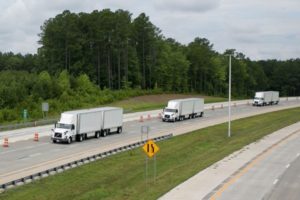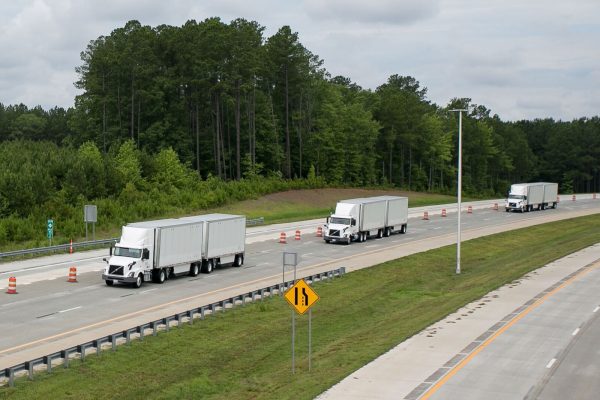FedEx Corp. is trying out new technology to tighten spacing between freight trucks traveling on the highway as a way to increase safety, relieve traffic congestion and reduce fuel consumption.
The test of a technique called “platooning” involves Volvo AB trucks pulling FedEx trailers separated by about 140 feet on a North Carolina toll road. Drivers in the two trailing vehicles need only steer while braking and acceleration are done by computer.
The “platoon” consisted of three trained, professional truck drivers in Volvo VNL tractors, each pulling double 28-foot trailers. Through CACC, a wireless vehicle-to-vehicle (V2V) communication technology, the tractors and trailers remained in constant communication. The tractors and trailers traveled at speeds of up to 62 mph while keeping a time gap of 1.5 seconds, maintaining a closer distance than what is typical for on-highway tractors. Staged and unplanned vehicle cut-ins demonstrated how the technology handles common traffic situations.
The vehicle-to-vehicle communication system helps reduce the reaction time for braking and enables vehicles to follow closer, automatically matching each other’s speed and braking. The advanced technology is meant to serve as an aid – not a replacement – for skilled professional truck drivers.

The operation marks the technology’s first on-highway test in the U.S., the companies said in a statement Wednesday. Fuel savings can range from 4 percent to 12 percent as drag is reduced on the two trucks following the leader.
“Most of all it’s a technology that we believe will enhance the safety of our vehicles,” said John Smith, chief of FedEx’s freight unit, in a telephone interview. “There’s an efficiency gain due to the fact that when you’re platooning like that, the aerodynamics change.”
The live trial relies on a Volvo-designed system to keep the vehicles in sync on maneuvers, and comes more than two years after the manufacturer platooned trucks through Europe to Rotterdam. The stretch of highway near Raleigh, North Carolina, is one of 10 locations the U.S. Department of Transportation has designated for demonstrating technologies that may lead to self-driving vehicles.
Volvo and other truck makers have been rolling out new systems such as automatic braking to avoid collisions and warnings when a truck drifts outside its lane as they work toward more autonomous vehicles.
“We know these technologies will be part of our future, but exact timing depends on many things, namely regulations, infrastructure, safety standards, and market demand,” said Per Carlsson, acting president of Volvo Trucks North America, in a statement.
Was this article valuable?
Here are more articles you may enjoy.


 CBS Poised to Lose Bid to Stop Sony Taking ‘Jeopardy’ Rights
CBS Poised to Lose Bid to Stop Sony Taking ‘Jeopardy’ Rights  LA Wildfires Had Little Impact on Reinsurer Risk Appetite During April Renewals
LA Wildfires Had Little Impact on Reinsurer Risk Appetite During April Renewals  Insurance Industry Contemplates Knock-On Effect of Tariffs to Claims, Consumers
Insurance Industry Contemplates Knock-On Effect of Tariffs to Claims, Consumers  Deutsche Bank’s DWS Pays $27M in German Greenwashing Case
Deutsche Bank’s DWS Pays $27M in German Greenwashing Case 